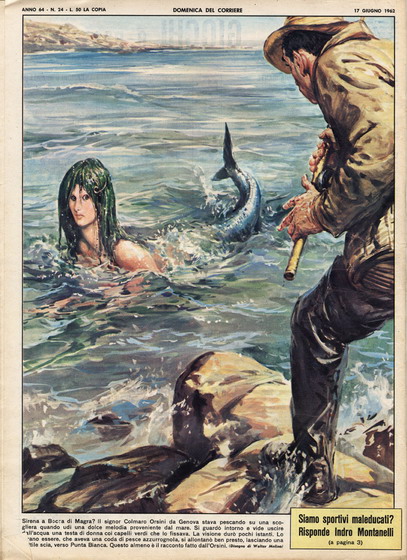
July 17, 2009
Brent Swancer, living in Japan, is our guest contributor for today. He introduces us to yet another interesting story about a unique Japanese cryptid:
Orang Ikan
by Brent Swancer
Merbeings. Whether you believe they are possible are not, it is undeniable that half human/half fish beings (above) are a recurring theme around the world and across cultural divides. In light of the recent talk of merbeings at Cryptomundo (see here, here & here), I thought I would share an interesting case that was reported by Japanese soldiers from the Kei Islands of Indonesia in 1943.
The Kei Islands, also known as the Kai Islands, are located in the south-eastern part of the Maluka Islands of Indonesia. The Kei Islands cover a total area of around 555 square miles and are famous for their beautiful beaches and unspoiled scenery. It was in this gorgeous island paradise of postcard perfect, pristine white sand beaches that a most peculiar and mysterious case occurred.
In 1943, Japanese soldiers stationed with a surveillance team on a small, remote island within the Kei island chain reported seeing strange creatures in the water that were said to have limbs and a face somewhat similar to a human, but a mouth like a carp. These creatures were described as being around 150 cm tall, and having pink skin, as well as prominent spines on their heads. Unlike classical mermaids, these merbeings did not have fish tails, but rather two arms and two legs.
On several occasions, these beings were seen cavorting about near beaches or in lagoons. In one case, two of the odd creatures were spotted playing in a lagoon, and another was reportedly seen swimming near a beach in a manner similar to a human doing the breast stroke. One report was told by a startled soldier who recalls seeing one of the creatures on a beach one night. At first the soldier had thought it was a child until it turned around and he could see in the moonlight that its facial features were not quite right. The creature quickly ran headlong into the water upon being seen and did not resurface.
Although the Japanese soldiers were deeply perplexed by these sightings, these creatures were not unknown to the indigenous people of the islands. When asked about them, villagers in the vicinity told the Japanese that they were known locally as the Orang Ikan. In Malay, Orangmeans “human” and Ikan means “fish,” so we have something akin to “man fish.” The villagers said that they were sometimes even caught in nets and that if another was captured in such a fashion, the Japanese would be informed.
One evening, the sergeant of the surveillance team, a Mr. Taro Horiba, was summoned by the chief of the nearby village. It was announced to Horiba that an Orang Ikan had been found dead on a beach earlier that day and the body was available for viewing. The sergeant was dumfounded by what he was to find sprawled out upon the grass at the chief’s home.
Horibe described the dead creature as being around 160 cm long and possessing a head of red-brown, shoulder length hair, and spines along the neck. The face was said to be quite ugly, with human-like and ape-like features; a low, short nose, a broad forehead, and small ears. The lipless mouth was wide like that of a fish, specifically described like that of a carp, and filled with tiny, needle-like teeth. The creature’s fingers and toes were long and webbed. Horiba also reported that there was some sort of algae attached all over its body.
Sergeant Horiba, although having sighted the Orang Ikan himself on several occasions, could not fathom what it was that he had seen at the chief’s home. There was no known creature residing on the island that could have possibly accounted for the dead creature he had witnessed, and the sight of the carcass had deeply disturbed him. Upon returning to Japan, Horiba told of his experiences and urged zoologists to go investigate the phenomena, but no one took him seriously. The fact that he had taken no photos did not help his cause, and in the end he was mostly ridiculed.
What is it these soldiers were seeing? What was that carcass at the chief’s house? Could there have been a real animal behind this case? The local villagers certainly seemed to think so, so here we have a classic case of an ethnoknown animal coming to the knowledge of baffled outsiders. It does not appear that these mysterious merbeings can be merely attributed to the wild imaginings of the foreign Japanese in a strange land under harsh conditions.
There is really no hard evidence available, but let’s take a moment to explore some possibilities.
Many merbeing sightings have been attributed to misidentifications of dugongs or manatees. Dugongs, although rare, were once found all over the Indo Pacific and could very well have existed in the areas of these Indonesian sightings. However, it seems unlikely that dugongs could be the culprit behind the reports of the Orang Ikan. Dugongs do not have two arms and two legs like Orang Ikan were reported to have, and it does not seem that a dugong’s face could be misconstrued as being all that human-like. Villagers would also have likely been able to make a distinction between any dugongs in the area and a merbeing. It was most definitely not the body of a dugong that sergeant Horiba described seeing at the village chief’s house.
What else could these strange creatures have been?
When pondering this case, I cannot help but notice the resemblance between these Orang Ikan and some other types of aquatic, ape-like beings that have been reported elsewhere. The Thetis Lake Gillman that was sighted at Thetis Lake on Vancouver Island in 1972, for instance, seems to share some Orang Ikan characteristics, as does the Pugwis merbeings of Native lore.
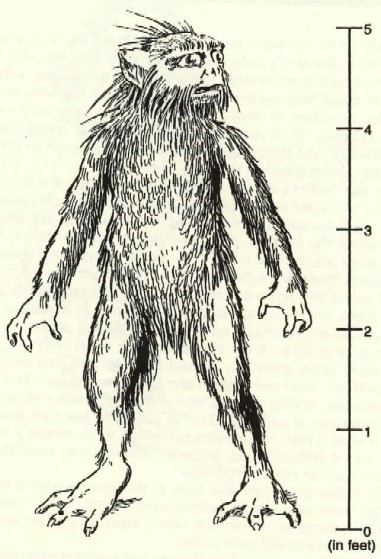
The Thetis Lake Monster above was drawn by Harry Trumbore for The Field Guide of Bigfoot and Other Mystery Primates.
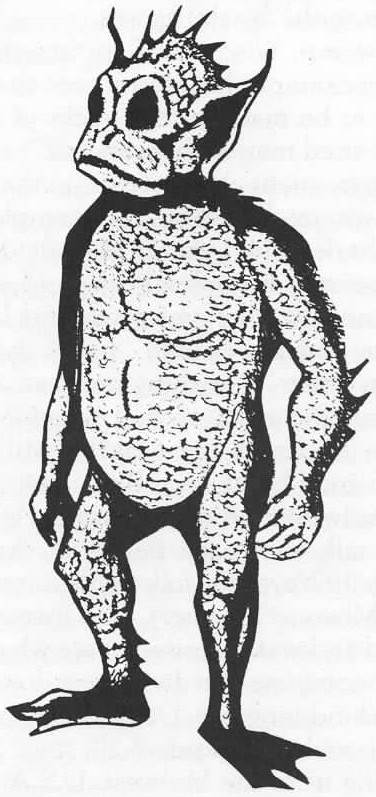
Newspaper version of the Thetis Lake Monster.
Pugwis and the Thetis Lake Monster, like the Orang Ikan, feature prominent spines or spikes on the head, two arms, two legs rather than a fish tail, webbed fingers and toes, and generally appear to be amalgam of ape and fish features. Could the Orang Ikan reported by the Kei Island natives and Japanese soldiers have been a similar sort of creature to these other cryptids?
One possibility is that all of these accounts have their basis in some sort of unknown primate that diverged long ago to adapt to an aquatic or semi-aquatic life. We could certainly expect such a primate to evolve some of the aquatic features mentioned in relation to the Orang Ikan, the Pugwis, and Thetis Lake monster. It is likely that an aquatic adapted ape-like creature would look more like these creatures than the classical mermaid image of a perfect human torso upon a perfectly fish-like tail.
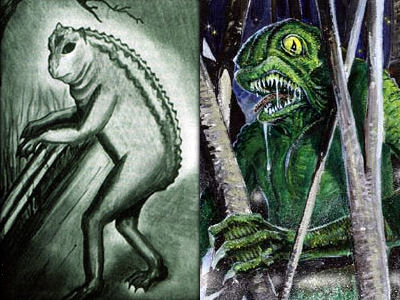
The Loveland Frog (two images above) also seems reminiscent of these ape-like Merbeings, as does the Kappa from Japan (below). Could the Orang Ikan be related to those cryptids, in some fashion?
The particular location of the Orang Ikan sightings also leads me to speculate on another possibility. The relatively recent unearthing in Indonesia of the fossils of Homo floresiensis also known as “Flores Man” or “the real Hobbit,” shows us that there was once a previously unknown type of pygmy hominid found there. It is not known what the specific range of Homo floresiensis was, and it seems possible they could very well have inhabited other Indonesian islands in addition to Flores island.
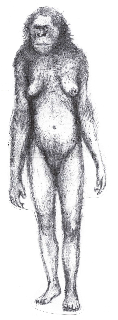
Professor Richard Klyver’s sketch of the Flores woman. The first fossil discovery of Homo floresiensis was of a female, not a male, although the media insist on labeling it the “Flores Man.”
Is it possible that these Flores hominids were also present on the Kei islands,and at some point adapted to a more aquatic habitat in this geographically isolated environment? It is thought by some researchers that Homo floresiensis may have had its small size due to island dwarfism, which is one possible adaptation to cope with limited resources in an island ecosystem. Perhaps an isolated population of Homo floresiensis could have dealt with the same pressures by adapting to a more aquatic lifestyle to take advantage of coastal resources. Coastal areas provide rich potential for food resources, so it does not seem completely unfeasible that a primate or early hominid could have perhaps evolved along these lines.
Could an aquatic adapted population of Homo floresiensis or some sort of primate explain these Indonesian merbeings? Or was it something else?
Whatever they were, the Orang Ikan presents a curious and little known mystery that has never been solved.
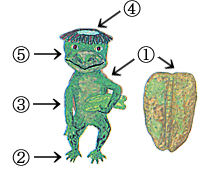
Key to the above Kappa drawing:
1) Shell,
2) Webbed hands and feet,
3) Elastic arms,
4) Plate, and
5) A tapering mouth.
About Loren Coleman
Loren Coleman is one of the world’s leading cryptozoologists, some say “the” leading living cryptozoologist. Certainly, he is acknowledged as the current living American researcher and writer who has most popularized cryptozoology in the late 20th and early 21st centuries.
Starting his fieldwork and investigations in 1960, after traveling and trekking extensively in pursuit of cryptozoological mysteries, Coleman began writing to share his experiences in 1969. An honorary member of Ivan T. Sanderson’s Society for the Investigation of the Unexplained in the 1970s, Coleman has been bestowed with similar honorary memberships of the North Idaho College Cryptozoology Club in 1983, and in subsequent years, that of the British Columbia Scientific Cryptozoology Club, CryptoSafari International, and other international organizations. He was also a Life Member and Benefactor of the International Society of Cryptozoology (now-defunct).
Loren Coleman’s daily blog, as a member of the Cryptomundo Team, served as an ongoing avenue of communication for the ever-growing body of cryptozoo news from 2005 through 2013. He returned as an infrequent contributor beginning Halloween week of 2015.
Coleman is the founder in 2003, and current director of the International Cryptozoology Museum in Portland, Maine.
Filed under Cryptomundo Exclusive, Cryptotourism, CryptoZoo News, Cryptozoology, Eyewitness Accounts, Folklore, Guest Blog, Merbeings